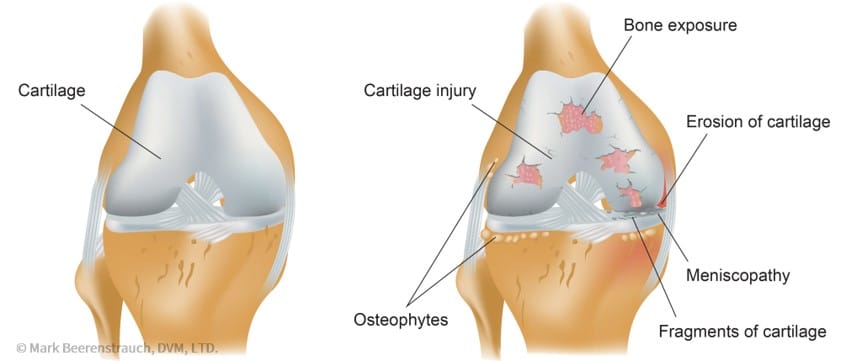Top 5 Signs of Arthritis in Dogs
What is arthritis?
Arthritis is a common ailment characterized by joint inflammation, resulting in pain and stiffness for our pets. Osteoarthritis denotes the gradual deterioration of joints, causing discomfort and restricting movement. 🐾
What causes arthritis?
While aging is a typical factor, arthritis can manifest early due to developmental issues such as hip or elbow dysplasia. Certain breeds, including Labradors, Springer Spaniels, German Shepherds, and Rottweilers, are more susceptible. Injuries like sprains or cruciate ruptures are common precursors to arthritis later in life.
Dr. B’s Top 5 Signs of Arthritis in Dogs

This diagram shows the secondary degenerative changes to cartilage with osteoarthritis.
1. Limping
Limping is a prevalent sign of arthritis, and depending on the affected joints, you may notice your pet favoring one or more legs. Classic arthritis presentation mirrors human experiences, where initial stiffness or pain may resolve with movement or warming up. The limping often returns after extended periods of rest, indicating joint discomfort.
2. Reluctance to Move or Exercise Intolerance
If your dog is reluctant to engage in activities they previously enjoyed, arthritis may be the culprit. Navigating stairs, once an easy task, can become challenging for dogs with osteoarthritis. Exercise intolerance, showcased by a decline in enthusiasm for walks or play, indicates joint pain.
Dr. B Insight – If your pet’s usual activities become burdensome, arthritis should be considered.
3. Change in Behavior
Arthritis can prompt noticeable changes in behavior. Irritability, often linked to pain, may lead pets to seek quiet areas and avoid interactions. Tiredness becomes apparent as movement discomfort increases, causing your pet to sleep more or be less eager for routine walks or playtime. Recognizing these changes and connecting them to potential arthritis ensures early intervention.
4. Licking or Chewing
Pets with arthritis often focus on painful joints through excessive licking, chewing, or biting. You might observe hair loss and inflamed skin in these areas.

An x-ray of a dog’s hip showing osteophytes and degenerative changes secondary to osteoarthritis.
Dr. B Insight – New behaviors in your pet, like persistent foot licking, should be investigated. Foot licking can be multifactorial, but one cause is underlying pain, including arthritis.
5. Vocalization
Arthritis can make affected joints sensitive to touch, leading dogs to vocalize when discomfort arises. Sensitivity around hurt areas, reluctance to be touched, and groaning during specific movements indicate joint pain.
Dr. B Insight – Even though many dogs may not overtly whine or vocalize, their lack of vocalization does not equate to a lack of pain. Dogs are adept at tolerating and hiding pain, emphasizing the importance of recognizing subtle signs.
As we explore these signs, stay tuned for upcoming blogs this month that will delve into various aspects of arthritis, from treatment options to recommended products and expert advice from our Pet Health veterinarians. Understanding these signs early is crucial for effective arthritis management.



